The 17th century in the Netherlands, often referred to as the Dutch Golden Age, was a period of extraordinary artistic efflorescence. As the newly independent Dutch Republic flourished economically and culturally, patronage for the arts expanded beyond the church and aristocracy to the increasingly prosperous merchant class. This shift fueled a demand for new genres of painting that resonated with bourgeois tastes, including landscapes, portraits, genre scenes, and, notably, still lifes. Within this vibrant artistic milieu, Isaac van Duynen (also spelled Duijnen or Duynen) emerged as a distinguished specialist, celebrated for his remarkably lifelike and evocative depictions of fish. Though perhaps not as universally recognized today as some of his contemporaries like Rembrandt van Rijn or Johannes Vermeer, Van Duynen's contribution to the still life genre, particularly his mastery over the challenging subject of marine life, secures him an important place in the annals of art history.
Early Life, Influences, and Artistic Formation
Isaac van Duynen was born in Dordrecht in 1628, a city with a rich artistic heritage that had previously nurtured talents like Aelbert Cuyp. The specifics of Van Duynen's early training remain somewhat obscure, a common challenge when reconstructing the biographies of many artists from this period. However, it is known that he spent a formative period in Rome between approximately 1651 and 1657. Italy, and Rome in particular, was a magnet for artists from across Europe, drawn by the legacy of classical antiquity and the High Renaissance. Many Northern European artists who journeyed south became part of a confraternity known as the "Bentvueghels" (Dutch for "birds of a feather"), a lively and sometimes boisterous group known for their camaraderie and initiation rituals. While direct records of Van Duynen's specific activities or affiliations within the Bentvueghels are scarce, his time in Rome would undoubtedly have exposed him to a wide range of artistic styles and influences, including the dramatic lighting of Caravaggio and his followers, which had a profound impact on many Dutch painters.
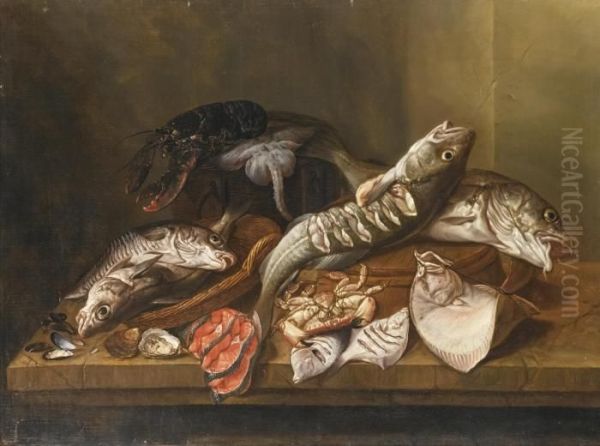
Upon his return from Italy, Van Duynen eventually settled in The Hague around 1657. The Hague was a significant artistic center, home to the Confrerie Pictura, a guild of painters established to protect and promote the interests of its members. It is documented that Van Duynen became a member of this prestigious guild, indicating his recognized status as a professional artist. It is also suggested that after 1664, while in The Hague, he may have been a student of, or at least significantly influenced by, Abraham van Beyeren (c. 1620/21–1690). Van Beyeren was a towering figure in Dutch still life painting, renowned for his opulent "pronkstilleven" (ostentatious still lifes) featuring sumptuous displays of fruit, silverware, and seafood, as well as his own masterful fish still lifes. The influence of Van Beyeren's rich textures and dynamic compositions can often be discerned in Van Duynen's subsequent work.
Artistic Style and Thematic Concerns
Isaac van Duynen's artistic reputation rests firmly on his exceptional skill in painting fish. In an era that prized verisimilitude, his ability to capture the slick, iridescent sheen of scales, the moistness of freshly caught seafood, and the varied textures of different species was highly admired. His works are characterized by a robust realism, where every detail, from the glint in a fish's eye to the rough grain of a wooden tabletop or the weave of a basket, is rendered with meticulous care. This dedication to detail did not result in static or lifeless representations; rather, Van Duynen imbued his scenes with a sense of immediacy and vitality.
His compositions are typically well-balanced, often featuring a central grouping of fish arranged on a simple wooden table, sometimes accompanied by a fishing net, a basket, or earthenware. The lighting in his paintings is often dramatic, with strong contrasts between light and shadow that serve to model the forms of the fish and create a sense of depth. This use of chiaroscuro, perhaps honed during his time in Italy, adds a theatrical quality to his arrangements. Van Duynen's palette was rich and varied, adeptly capturing the silvery gleam of herring, the pinkish hues of salmon, or the darker tones of other species. He often employed a contrast between the cool, silvery tones of the fish and the warmer, earthy browns and ochres of the wooden surfaces or baskets, creating a harmonious yet dynamic visual effect.
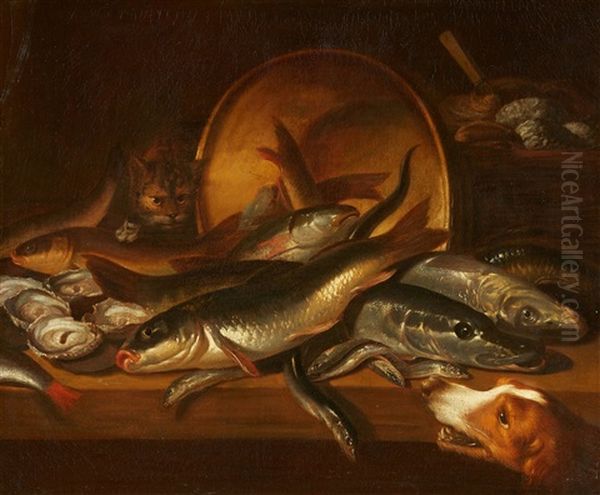
Beyond their technical brilliance, Van Duynen's fish still lifes, like many Dutch still lifes of the period, likely carried symbolic meanings. Fish, in Christian iconography, could symbolize Christ (the ichthys symbol). More broadly, in the context of "vanitas" still lifes – a genre that emphasized the transience of life and the futility of earthly pleasures – perishable items like fish served as potent reminders of mortality and the fleeting nature of existence. The Dutch, living in a predominantly Calvinist society, were receptive to such moralizing undertones, even amidst their celebration of worldly abundance. Van Duynen's paintings thus operated on multiple levels: as stunning displays of artistic skill, as celebrations of the bounty of the sea (a vital resource for the Dutch economy), and as subtle meditations on life and death. His work reflected the complexities of 17th-century Dutch society, which grappled with newfound prosperity alongside enduring religious and philosophical concerns.
Representative Works and Notable Compositions
Among Isaac van Duynen's most characteristic and celebrated works is Still Life with Fish on a Table. This painting, and others like it, exemplifies his signature style. Typically, such a composition would feature an assortment of fish – perhaps cod, haddock, plaice, or herring – artfully arranged on a wooden slab or table. The artist's skill is evident in the rendering of the diverse textures: the rough, matte surface of some fish contrasted with the glistening, wet appearance of others. The scales catch the light, creating a play of reflections that adds to the realism. The surrounding elements, whether a simple knife, a piece of string, or a rough basket, are rendered with equal care, contributing to the overall verisimilitude of the scene. The interplay of light and shadow sculpts the forms, giving them a three-dimensional presence.
Another example of his prowess might be a work titled something akin to Still Life with Fish and a Cat, a theme explored by several Dutch artists. In such a painting, the inclusion of a live animal, often a cat eyeing the fish with predatory interest, would add a narrative element and a touch of dynamism to the composition, contrasting the stillness of the dead fish with the alertness of the feline. These works showcase not only Van Duynen's ability to paint fish but also his capacity to create engaging and complex scenes.
While specific titles can vary or be descriptive rather than original, the consistent theme in Van Duynen's oeuvre is the meticulous and respectful depiction of marine life. His paintings often focus solely on the fish themselves, allowing their natural forms and textures to be the primary subject, unlike some contemporaries who might embed them in more elaborate kitchen scenes or market stalls. This focused approach highlights his deep appreciation for his chosen subject matter.
Contemporaries and the Artistic Milieu of The Hague
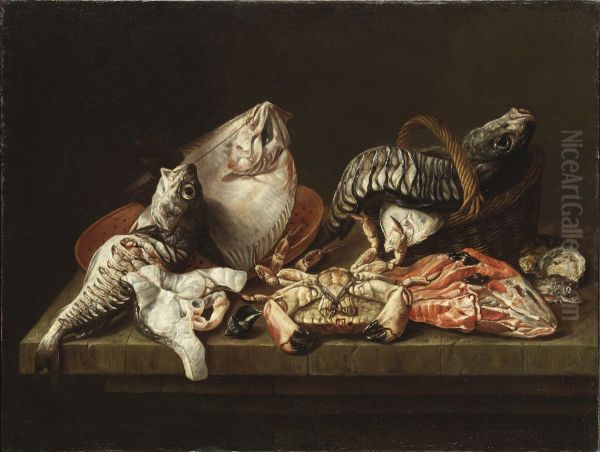
Isaac van Duynen operated within a rich and competitive artistic environment. His connection with Abraham van Beyeren in The Hague is significant. Van Beyeren was not only a master of fish still lifes but also of lavish banquet pieces. His influence likely encouraged Van Duynen to refine his technique and perhaps explore more complex arrangements. The Hague's Confrerie Pictura included many notable artists, fostering an atmosphere of both collaboration and rivalry.
Other artists specializing in or frequently depicting fish still lifes during this period included Pieter de Putter (c. 1600–1659), an earlier master who helped establish the genre, and Jacob Gillig (c. 1636–1701) in Utrecht, whose works often feature river fish. While Van Duynen's style is distinct, he was part of a broader tradition. His work can also be seen in the context of other still life painters who, while not exclusively focused on fish, often incorporated them into their compositions. For instance, the "monochrome banketjes" (monochromatic breakfast pieces) of Willem Claesz. Heda (1594–1680) and Pieter Claesz (1597–1660) sometimes included herring or other fish alongside pewter plates, roemer glasses, and half-peeled lemons, emphasizing texture and subtle tonal variations.
The user-provided information mentions stylistic similarities or comparisons with Adriaen Coorte (active c. 1683–1707) and Abraham van Calraet (1642–1722). Coorte, known for his intimate and meticulously detailed still lifes, often featuring a few objects like asparagus or shells against a dark background, shares Van Duynen's intense focus on texture and light, though Coorte's compositions are generally more minimalist. Abraham van Calraet, active in Dordrecht, painted a variety of subjects, including still lifes that sometimes featured fish, and his detailed realism would have been in line with the prevailing tastes.
The mention of Pieter van Mase and Willem Ormea (c. 1611 – c. 1673) in relation to shared themes like sturgeon and beach scenes further contextualizes Van Duynen's work. Ormea, for instance, is known to have collaborated with landscape painters like Isaac Willaerts (1620-1693), who would paint the coastal or beach settings while Ormea added the fish, often depicting catches laid out on the shore. This collaborative practice was not uncommon and highlights the specialization within the Dutch art market. If Van Duynen also depicted such scenes, it would place him in direct thematic dialogue with these artists. The depiction of sturgeon, a large and impressive fish, would have been a subject allowing for a particularly grand display of painterly skill.
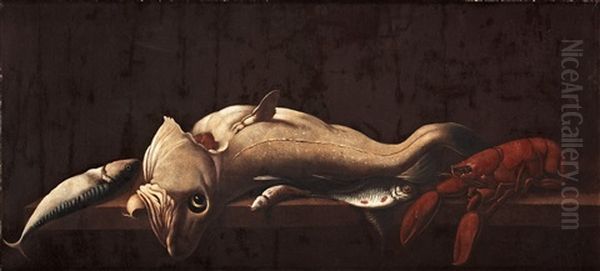
The broader landscape of Dutch still life painting also included masters like Jan Davidsz. de Heem (1606–1684), whose elaborate "pronkstilleven" were bursting with fruit, flowers, and expensive objects, and female artists like Clara Peeters (1594–c. 1657), an early pioneer of still life, and Rachel Ruysch (1664–1750), celebrated for her exquisite flower paintings. While their subject matter differed, they all shared the Dutch preoccupation with detailed observation and the celebration of the material world, often imbued with symbolic meaning.
Life's Anecdotes and Other Pursuits
Detailed personal anecdotes about Isaac van Duynen's life are, unfortunately, quite limited, which is common for many artists of his era unless they achieved the level of fame that invited contemporary biographers like Karel van Mander (though Van Mander's Schilder-boeck predates Van Duynen's main period of activity) or Arnold Houbraken. Most of what is known about Van Duynen is inferred from official records (like guild memberships or mentions in inventories) and, of course, through the careful study of his paintings.
The suggestion that he might have been involved in commercial activities beyond painting, such as dealings related to arms and ammunition, is intriguing. It would not have been entirely unusual for individuals in the 17th century to engage in multiple enterprises. The Dutch Republic was a hub of international trade, and artists were not always solely reliant on their artistic output for income. However, without more substantial documentary evidence, such claims remain speculative. His primary legacy and the most concrete evidence of his life's work remain his canvases. His dedication to his craft is evident in the consistent quality and specialized focus of his paintings.
Teacher-Student Relationships: A Matter of Record and Speculation
The precise nature of Isaac van Duynen's own tutelage, beyond the likely influence or potential studentship under Abraham van Beyeren in The Hague, is not definitively recorded. The apprenticeship system was the standard mode of artistic training in the 17th century. A young aspiring artist would typically spend several years in the studio of a master, learning the craft from grinding pigments and preparing canvases to eventually copying the master's works and developing their own style. Given Van Duynen's skill, he undoubtedly underwent rigorous training, but the names of his earliest masters in Dordrecht are not known.
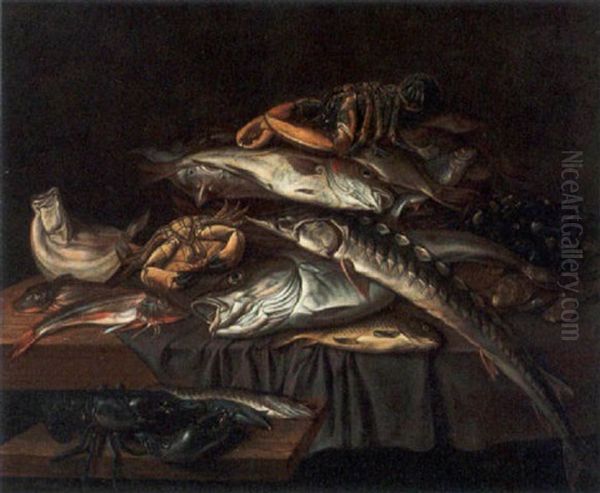
Similarly, there is no definitive list of students or disciples who trained directly under Isaac van Duynen. While it's plausible that an established master like him, a member of the Hague guild, might have taken on apprentices, specific names have not been prominently passed down in art historical records. His influence would more likely have been disseminated through the general admiration for his works and the adoption of his stylistic traits or subject matter by other painters who saw his paintings in collections or exhibitions. The impact of an artist is not solely measured by the number of direct pupils but also by the broader resonance of their work within the artistic community and among subsequent generations.
Artistic Influence and Enduring Legacy
Isaac van Duynen's influence is most keenly felt within the specialized domain of fish still life painting. He brought a level of dedication and refinement to this subgenre that helped elevate its status. His ability to render the varied textures and sheens of fish with such convincing realism set a high standard. Later artists tackling similar subjects would have looked to masters like Van Duynen and Van Beyeren as exemplars. His work contributed to the rich tapestry of Dutch Golden Age still life, demonstrating that even seemingly humble subjects could be vehicles for profound artistic expression and complex symbolic meaning.
His paintings serve as valuable historical documents, offering insights into the types of seafood consumed in the 17th-century Netherlands and the importance of the fishing industry to the Dutch economy. More significantly, they reflect the cultural values of the era: the appreciation for skilled craftsmanship, the celebration of material abundance, and the underlying awareness of life's transience. The enduring appeal of his work lies in its combination of technical virtuosity and subtle emotional resonance.
In the centuries since his death (around 1679-1681), Isaac van Duynen's paintings have been sought after by collectors and are now found in the collections of reputable museums worldwide. For instance, his works are held in institutions such as the National Museum in Lisbon and the Museum Boijmans Van Beuningen in Rotterdam, among others. Their inclusion in such collections attests to his recognized skill and art historical importance. Modern exhibitions of Dutch Golden Age art often feature still lifes, and works by painters like Van Duynen provide crucial insights into the diversity and richness of this period. Art historians and connoisseurs continue to appreciate his meticulous technique, his sensitive handling of light and color, and the quiet dignity he brought to his specialized subject.
Conclusion: The Enduring Appeal of Van Duynen's Art
Isaac van Duynen stands as a testament to the depth and specialization that characterized the Dutch Golden Age of painting. While he may not have explored the wide range of subjects tackled by some of his more famous contemporaries, his focused dedication to the fish still life allowed him to achieve a remarkable degree of mastery. His canvases are more than mere depictions of seafood; they are intricate studies of texture, light, and form, imbued with the cultural and symbolic resonances of his time. He captured the slick, silvery beauty of his subjects with an honesty and skill that continue to captivate viewers today. As an art historian, one appreciates Van Duynen not only for his technical prowess but also for his contribution to a unique and fascinating genre, offering a window onto the material world and intellectual concerns of 17th-century Holland. His legacy is preserved in the luminous, detailed, and quietly profound paintings that bear his name, securing his place as a significant master of the Dutch still life.